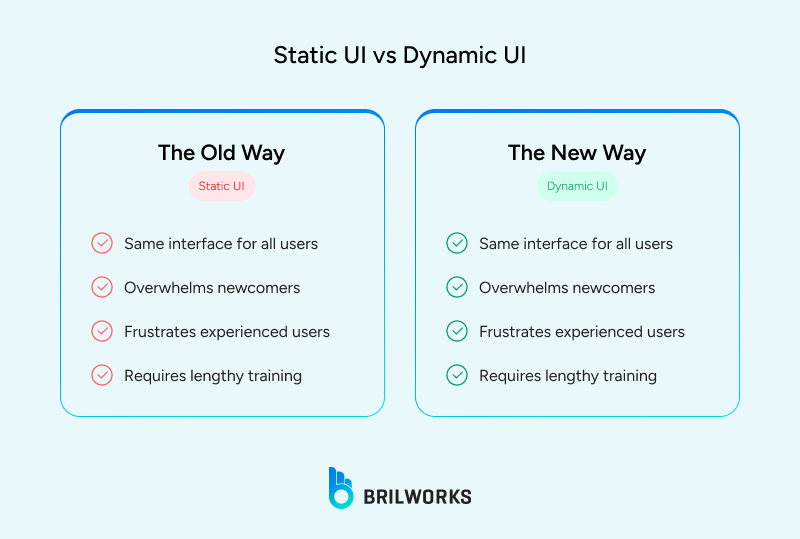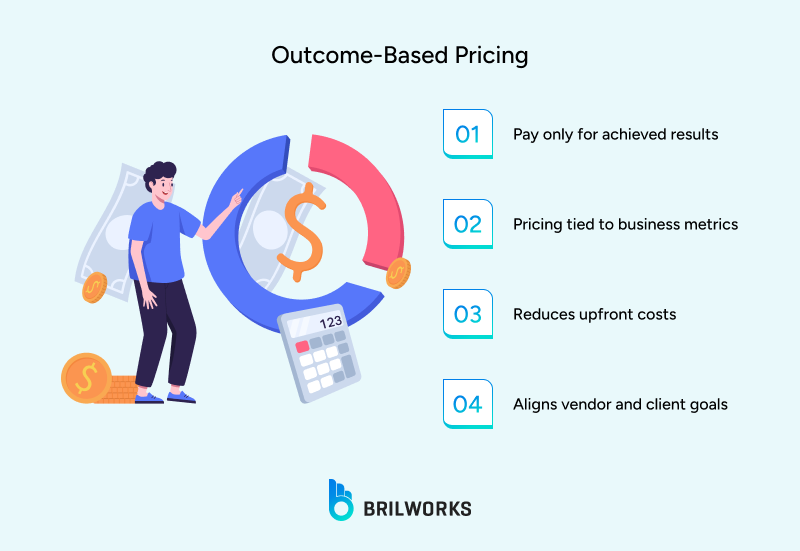COOPERATION MODEL
ARTIFICIAL INTELLIGENCE
PRODUCT ENGINEERING
DevOps & Cloud
LOW-CODE/NO-CODE DEVELOPMENT
FRONTEND DEVELOPMENT
CLOUD DEVELOPMENT
MOBILE APP DEVELOPMENT
LOW CODE/ NO CODE DEVELOPMENT
EMERGING TECHNOLOGIES








The Software as a Service (SaaS) model has always been about shared resources, subscriptions, and cloud scalability. Over the last 10 years, most improvements have centered on user interfaces, integrations, and performance.
Now, artificial intelligence is driving a new wave of innovation, enabling SaaS developers to rethink their development strategy. This shift is being defined by five core transformations that are fundamentally changing how SaaS is architected, developed, sold, and used.
The SaaS trends of 2025 focus on reevaluating the purpose of software, rather than just adding extra features. The five shifts—Agentic Workflows, the Predictive Data Core, Dynamic UI Generation, Self-Healing Architectures, and Outcome-Based Pricing—are interconnected.
You need agentic workflows to achieve outcome-based pricing since they produce the outcomes. Reliable agents depend on a self-healing architecture to operate. An intelligent architecture requires a predictive data core to function effectively. Finally, a dynamic UI is necessary for interaction, making the entire system accessible.
Over the last ten years, automation has been the gold standard for SaaS efficiency. Tools like Zapier and Workato thrived by using simple "if-this-then-that" (IFTTT) logic. While this approach was powerful, it had its flaws. It required users to manually set up every trigger, action, and decision path, making it somewhat fragile and heavily reliant on human input.
Agentic Workflows mark a huge leap forward from traditional automation, shifting from rigid, user-defined tasks to intelligent, adaptive systems powered by AI. These AI agents can understand high-level goals, create plans to achieve them, and adjust when things don’t go as expected.
Old automation had its limits. For example, before AI, you might set up a rule in Gmail to detect emails with “invoice” in the subject, save the attachment to a specific Google Drive folder, and send a Slack message to #accounting with the file link.
But it had a problem. If the email says "payment request" instead of "invoice," or if the attachment is a .zip file, the automation breaks down. Now, AI agents understand these nuances to make automation smooth.
For SaaS development, this means the entire backend is being re-imagined. Developers are now building a "toolbox" of capabilities (like "send email," "read database," "generate report") that a central AI agent can pick up.
For 20 years, databases have acted as filing cabinets. They served as passive components, holding information until a user or application requested it. Analytics and BI tools were built on this data, forcing users to pull insights by creating reports and dashboards.
The AI-native approach changes this model. The data has now become an active Predictive Data Core. AI within the architecture transforms the data layer from a simple database into an intelligent, real-time inferencing engine.
Each new piece of data entering the system gets instantly analyzed, cross-referenced, and used to update a predictive model. In this setup, the application's brain is the data itself.
Let’s understand the difference between traditional (reactive analysis) and modern (predictive analysis).
The Old Way (Reactive Analytics):
A sales manager logs into their CRM. They run a report asking, "Show me my team's conversion rate for last month." They look at the past and find out that the team missed its quota. Now they must react and figure out why.
The New Way (Predictive Data Core):
A sales manager logs into their CRM. A proactive alert appears: "Warning: Your Q4 forecast is at high risk. Based on current call/email sentiment analysis and a 30% drop in demo-to-trial conversions in your mid-market segment, you are projected to miss your quota by 12%.
The AI has identified 15 high-intent accounts from last quarter that stalled. We suggest launching 'Campaign-Rebound' (AI-generated) to re-engage them immediately."
In this new model, the application continually runs "what-if" scenarios in the background.
For developers, the roles of data scientist and backend engineer are merging. They need to work closely together. The most valuable SaaS platforms of 2025 won’t just store your data; they will understand it and tell you what to do with it before you even know to ask.
The software development industry spent 30 years perfecting the graphical user interface (GUI). Design systems, role-based access controls, and complex dashboards were created.
The goal was to create a "one-size-fits-all" experience that could also be customized. The result is often a bloated, complex interface where 90% of users only use 10% of the features.
Generative AI is changing this. Dynamic UIs are taking over static UIs. In this approach, the user interface should not be pre-built. Instead, AI should generate it in real-time based on the specific user’s activities. It's the "interface of one." 
Below are a few popular examples of generative UI that we often interact with.
AI-powered website builders
Smart form generators
Automated dashboard design
Personalized app layouts
AI-assisted design tools
Content recommendation panels
Downtime is a major issue for SaaS. The business model depends on trust and availability. For years, we have focused on achieving "high availability" (HA) and "disaster recovery" (DR) models, all managed by on-call DevOps and SRE (Site Reliability Engineering) teams. This approach is reactive and relies on human involvement.
The next step is a Self-Healing SaaS Architecture, where the application can manage its own uptime. A self-healing architecture uses advanced AI models, part of a trend called AIOps, to actively monitor its own health, predict failures before they happen, and automatically take corrective actions without human help.
This goes beyond simply scaling. Self-healing architectures can spot and isolate "poison pill" data that crashes a microservice, automatically reroute traffic around a failing network area, or even identify a new zero-day vulnerability and automatically create and implement a hot-patch to the code.
For as long as SaaS has been around, we have sold it in one of two ways: per-seat (per-user) or per-use (per-API-call). This model is straightforward, but it creates a major issue. The customer pays for access to a tool, not for the value that the tool provides.
For the first time, AI makes the value itself measurable and attributable. This is driving the biggest change in SaaS business models: Outcome-Based Pricing.
This pricing model charges the customer for a verified, successful business result instead of a license to use the software. The SaaS provider is so confident in its AI's ability to deliver value that it is willing to base its revenue on this.
See Also: The Ultimate Guide to White-Label SaaS Development
This serves as the blueprint for the AI-native company. Developers are shifting from simply writing code to training models and creating autonomous systems. Founders are no longer just selling features; they now provide guaranteed outcomes. Users have moved beyond being operators; they are now directors, setting strategies for teams of intelligent AI agents.
The shift will be challenging for established companies that think an "AI-GPT" chatbot added to their outdated app is sufficient. For the new wave of AI SaaS developers ready to build from scratch, this represents not just an opportunity but a completely new landscape.
Get In Touch
Contact us for your software development requirements
Get In Touch
Contact us for your software development requirements